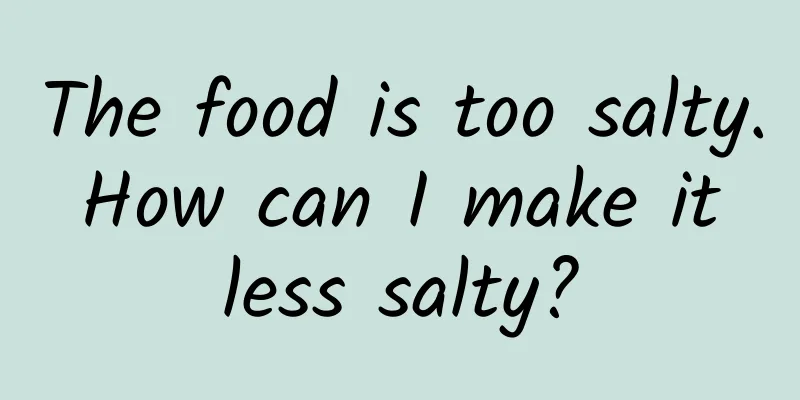Diet for hemodialysis patients

|
If a patient needs to undergo hemodialysis, it is most likely that there is a serious problem with his kidney function. Hemodialysis is very harmful to the patient's body, so after hemodialysis, the patient must not only lie down and rest, but also pay attention to his diet. Because if the patient's diet is inappropriate after hemodialysis, it will cause a series of hemodialysis sequelae. What dietary considerations should patients take after hemodialysis? 1. Dietary taboos for hemodialysis patients: 1. Control your fluid intake Especially water, weight gain should be controlled to no more than 4% between every dialysis sessions. The amount of water you should drink should generally be equal to an increase of 500ml in urine volume from the previous day. The temperature of drinking water should be appropriate. You should drink ice water or hot water. It is not advisable to drink warm water. Do not drink large amounts of water continuously. When drinking, you should take a full mouthful of water and swallow it all at once. 2. Protein and calories should not exceed the standard The protein intake is 1.2 to 1.4 g/(kg·day). This refers to the protein intake that can fully meet the needs of dialysis patients, 50% of which should be high-quality protein. Optional foods include: eggs, milk, lean meat, fish, etc. Be careful not to use soy products or hard nuts. Other edible carbohydrates and some staple foods. Protein intake exceeding the standard should not be taken as it may cause long-term complications. The daily calorie supply is 125-146 kJ/kg (30-35 cal/kg). 3. Limit sodium intake Patients with normal urine volume do not need to restrict sodium intake. Patients with reduced urine volume should limit their sodium intake, generally not exceeding 5g per day. Patients with anuria should control their daily sodium intake to 1-2g. 4. Limit potassium intake Potassium intake may depend on the condition. The general daily intake is 2 to 2.5g. Foods containing potassium should be used with caution, such as mushrooms, seaweed, beans, lotus seeds, cabbage, mustard tuber, bananas, oranges, peanuts, scallops, celery, pumpkin, high-quality protein and animal organs. Do not overeat to prevent the occurrence of hyperkalemia. The harm of high potassium is very serious and can endanger the patient's life. 5. Limit phosphorus intake Phosphorus intake should be limited to 600-1200 mg per day. Phosphorus is found in almost all foods. You should avoid consuming foods rich in phosphorus, such as egg yolks, whole wheat noodles, animal offal, dry beans, nuts, milk powder, chocolate, dried shrimps, millet, mung beans and soft drinks. You should control the intake of these foods in appropriate amounts. Tips for dialysis patients to control excessive salt intake: 1. Salt, soy sauce, MSG, tomato sauce, etc. contain a lot of sodium. Processed and canned foods also contain a lot of sodium. Therefore, try to choose natural and fresh foods, avoid over-seasoning, and enjoy the unique flavor of the food itself; choose raw materials that are easy to taste (such as eggs). 2. When cooking, you can use more sugar, white vinegar, onion, ginger, garlic, five-spice, cinnamon, pepper, coriander, lemon, etc. to give food other flavors and increase its palatability. 3. When cooking, if you add soy sauce to one of the dishes, you can use vinegar, salad dressing, etc. to season the other dishes. Do not add soy sauce or salt to dishes containing vinegar. 4. Do not add base ingredients (such as salt before cooking, salt for pickling before frying, and salt for kneading vegetables). 5. Avoid eating cooked food that is made by grinding meat and then adding other ingredients. 6. Eat less processed foods such as sausages, ham, pickles, mustard tubers, fermented tofu, salted vegetables, dried tofu, etc. If you want to eat pickles, you can pickle them less strongly, or eat pickles that are only pickled for one night. 7. Adding salt after cooking is also a good way to avoid excessive salt intake. 3. Factors causing malnutrition in dialysis patients: 1. Insufficient intake. ① Toxin stimulation from uremia itself, poor gastrointestinal function, and inadequate dialysis. ② Dialysis patients absorb glucose in the peritoneal dialysis fluid into the blood, reducing their appetite. ③After the peritoneal dialysis fluid enters the abdominal cavity, the abdomen feels bloated. ④ Adverse reactions such as nausea and vomiting caused during hemodialysis and varying degrees of protein loss during dialysis can also cause malnutrition. ⑤Caused by adverse reactions of certain drugs. 2. Associated infectious diseases. The further consumption of body protein and fat worsens the nutritional status and causes metabolic and hormonal disorders. 3. The disease itself is often accompanied by carbohydrate, protein, fat metabolism disorders and endocrine disorders. In order to meet the needs of certain treatments, excessive nutritional control often occurs, leading to poor nutrient structure, excessive loss, insufficient nutrient absorption, etc. |
<<: Clear fluid leaks out during erection
>>: Clear mucus discharge during late pregnancy
Recommend
What are the functions and effects of Chinese herbal slimming tea?
Losing weight is always a topic that female frien...
Homemade whitening mask that works fast
Facial mask is one of the must-have beauty produc...
What does liver calcification mean?
Some people found some calcification foci in the ...
Symptoms of anorexia
In our lives, many female friends go on a diet to...
What to do if you have pain in the left lumbar spine
Sitting for a long time and doing heavy work may ...
Side Effects of Citrus aurantium
The medicinal material Citrus aurantium can treat...
What to do if the baby has wind in the stomach
When the baby's belly is windy, you must pay ...
Causes of body odor
Many people have body odor, and there are some re...
What causes typhoid fever? How to treat it?
The fog, dew, rain and humidity in spring and aut...
The efficacy of boiling water with white radix
Have you ever heard of Houttuynia cordata root? I...
How to do Chorionic Villus Sampling
I believe everyone knows how to perform the chori...
Can I remove fat particles on my scalp?
The appearance of fat particles on the scalp is m...
How to cook fresh bamboo fungus
The nutritional value of bamboo fungus is relativ...
Snake whip pills effects
Snakes are an animal that we are relatively famil...
What to do if your feet are burned by the exhaust pipe
People who ride motorcycles all have this experie...









